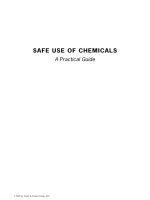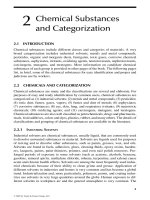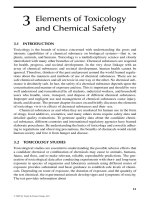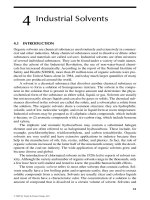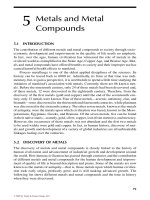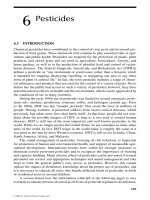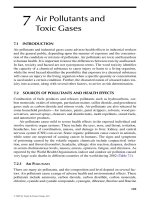SAFE USE OF CHEMICALS: A Practical Guide - Chapter 1 pot
Bạn đang xem bản rút gọn của tài liệu. Xem và tải ngay bản đầy đủ của tài liệu tại đây (385.24 KB, 17 trang )
SAFE USE OF CHEMICALS
A Practical Guide
© 2009 by Taylor & Francis Group, LLC
SAFE USE OF CHEMICALS
A Practical Guide
T. S. S. Dikshith
CRC Press is an imprint of the
Taylor & Francis Group, an informa business
Boca Raton London New York
© 2009 by Taylor & Francis Group, LLC
CRC Press
Taylor & Francis Group
6000 Broken Sound Parkway NW, Suite 300
Boca Raton, FL 33487-2742
© 2009 by Taylor & Francis Group, LLC
CRC Press is an imprint of Taylor & Francis Group, an Informa business
No claim to original U.S. Government works
Printed in the United States of America on acid-free paper
10 9 8 7 6 5 4 3 2 1
International Standard Book Number-13: 978-1-4200-8051-3 (Hardcover)
This book contains information obtained from authentic and highly regarded sources. Reasonable
efforts have been made to publish reliable data and information, but the author and publisher can-
not assume responsibility for the validity of all materials or the consequences of their use. The
authors and publishers have attempted to trace the copyright holders of all material reproduced
in this publication and apologize to copyright holders if permission to publish in this form has not
been obtained. If any copyright material has not been acknowledged please write and let us know so
we may rectify in any future reprint.
Except as permitted under U.S. Copyright Law, no part of this book may be reprinted, reproduced,
transmitted, or utilized in any form by any electronic, mechanical, or other means, now known or
hereafter invented, including photocopying, microfilming, and recording, or in any information
storage or retrieval system, without written permission from the publishers.
For permission to photocopy or use material electronically from this work, please access www.copy-
right.com ( or contact the Copyright Clearance Center, Inc. (CCC), 222
Rosewood Drive, Danvers, MA 01923, 978-750-8400. CCC is a not-for-profit organization that pro-
vides licenses and registration for a variety of users. For organizations that have been granted a
photocopy license by the CCC, a separate system of payment has been arranged.
Trademark Notice: Product or corporate names may be trademarks or registered trademarks, and
are used only for identification and explanation without intent to infringe.
Library of Congress Cataloging-in-Publication Data
Dikshith, T. S. S.
Safe use of chemicals : a practical guide / author, T.S.S. Dikshith.
p. cm.
Includes bibliographical references and index.
ISBN 978-1-4200-8051-3 (alk. paper)
1. Chemicals Safety measures. I. Title.
TP149.D545 2008
660’.2804 dc22 2008019076
Visit the Taylor & Francis Web site at
and the CRC Press Web site at
© 2009 by Taylor & Francis Group, LLC
v
Contents
Preface xi
Acknowledgments xv
The Author xvii
Chapter 1 Introduction 1
1.1 Chemical Substances and Poisoning of Humans 2
1.2 General Safety Guidelines 3
References 4
Chapter 2 Chemical Substances and Categorization 5
2.1 Introduction 5
2.2 Chemicals and Categorization 5
2.2.1 Industrial Solvents 5
2.2.2 Metals and Metal Compounds 6
2.2.3 Pesticides 6
2.2.4 Toxic Dust, Fumes, Gases, and Vapors 7
2.2.4.1 Fumes and Dust of Metals 7
2.2.5 Asphyxiates 8
2.2.6 Corrosive Substances 8
2.2.7 Irritants 9
2.2.7.1 Eye and Skin Irritants 9
2.2.7.2 Lung and Respiratory Irritants 9
2.2.8 Neurotoxic Chemicals 10
2.2.9 Oxidizing Agents 10
2.2.10 Carcinogens, Mutagens, and Teratogens 12
2.2.11 Chemicals and Fire Hazards 12
2.3 Conclusion 12
References 12
Chapter 3 Elements of Toxicology and Chemical Safety 15
3.1 Introduction 15
3.2 Toxicology Studies 15
3.2.1 History of Toxicology 16
3.2.2 Branches of Toxicology 19
3.2.3 Types of Toxicological Studies 21
3.2.3.1 Acute Toxicity 21
3.2.3.2 Chronic Toxicity 22
3.2.4 Inuencing Factors 25
© 2009 by Taylor & Francis Group, LLC
vi Contents
3.2.4.1 Dose–Time Relationship 25
3.2.4.2 Routes of Exposure and Toxicity Tests 25
3.2.5 Parameters of Toxicity 26
3.2.5.1 Parameters and the Safety Evaluation of Chemicals
and Drugs 26
3.3 Good Laboratory Practice and Regulations 26
3.3.1 Good Laboratory Practice 27
3.3.2 Toxicology Test Report 28
References 29
Appendix 3.1: Signs and Symptoms of Toxicity 30
Chapter 4 Industrial Solvents 31
4.1 Introduction 31
4.2 Solvents 32
4.2.1 Flammable and Combustible Solvents 33
4.2.2 Uses of Solvents 34
4.2.3 Exposure to Solvents 35
4.3 Drugs, Pharmaceutical Products, and Residual Solvents 36
4.4 Solvents and Precautions 37
4.5 Education and Training 40
4.6 Toxicity and Health Effects 40
4.7 Neurotoxicity 41
4.8 Solvent Syndrome and Fetal Defects 41
4.9 Workplace Controls and Work Practices 42
4.10 Occupational Exposure Limits 42
4.11 Solvents and Toxicity Prole 42
4.12 Conclusion 71
References 71
Appendix 4.1: Classes of Different Chemical Substances and Solvents 76
Appendix 4.2: Health Hazards of Solvents upon Inhalation 78
Chapter 5 Metals and Metal Compounds 79
5.1 Introduction 79
5.2 Discovery of Metals 79
5.3 Different Metals 81
5.3.1 Metals and Alloys 81
5.4 Metal Poisoning and Symptoms 82
5.5 Conclusions 102
References 103
Appendix 5.1: Metals and Health Disorders in Humans 107
Chapter 6 Pesticides 109
6.1 Introduction 109
6.2 Global Development of Pesticides 110
© 2009 by Taylor & Francis Group, LLC
Contents vii
6.3 Classications of Pesticides 110
6.4 Uses of Pesticides 113
6.5 Toxicity of Pesticides 114
6.6 Signs and Symptoms of Toxicity 114
6.7 Pesticide Management 115
6.8 Symptoms of Pesticide Poisoning 118
6.9 Approaches to Reduce Intentional and Suicidal Poisonings 120
6.10 The Insecticide Act (1968) 120
6.11 Regulations 121
6.12 Pesticides and Carcinogenicity 122
6.13 Conclusion 122
References 123
Appendix 6.1: Global Development of Pesticides 124
Appendix 6.2: Pesticide Poisoning—Mild, Moderate, and Severe 125
Appendix 6.3: Pesticide Components, Signs of Toxicity, and Parts of the
Body Affected 126
Appendix 6.4: Behavioral and Nonbehavioral Changes Caused by Pesticide
Exposure 126
Appendix 6.5: Pesticides and Mammalian Toxicity 126
Appendix 6.6: Pesticides and Hormone Disturbances in Mammals 129
Appendix 6.7: Classication of Pesticide Toxicity 129
Appendix 6.8: Organochlorinate Pesticides and Carcinogenicity 130
Appendix 6.9: Classication of Pesticides and Carcinogenicity 130
Appendix 6.10: Pesticides Listed in India as Carcinogens 136
Chapter 7 Air Pollutants and Toxic Gases 139
7.1 Introduction 139
7.2 Sources of Pollutants and Health Effects 139
7.2.1 Air Pollutants 139
References 158
Chapter 8 Chemical Substances and Carcinogenicity 161
8.1 Introduction 161
8.2 Carcinogens and Carcinogenesis 161
8.3 Classication of Carcinogens 162
8.4 Chemical Substances, Occupations, and Cancer 164
8.5 Children and Pesticide-Induced Cancer 167
References 167
Additional Reading 168
Appendix 8.1: Known Human Carcinogens 169
Appendix 8.2: Group B2—Probable Human Carcinogens 170
Appendix 8.3: Group E—Evidence of Noncarcinogenicity for Humans 171
Appendix 8.4: Classication of Benign and Malignant Tumors in Mammals 172
© 2009 by Taylor & Francis Group, LLC
viii Contents
Chapter 9 Chemical Substances and Neurotoxicity 173
9.1 Introduction 173
9.2 Neurotoxicity 174
9.3 Industrial Chemicals and Neurotoxicity 176
9.4 Monomers 177
9.5 Neurotoxicity and Children 178
9.6 Symptoms of Neurotoxicity 178
9.7 Polyneuropathy 178
9.8 Encephalopathy 179
9.9 Neurotoxicants and Neonates 180
9.10 Conclusion 180
References 181
Appendix 9.1: Chemical Substances and Neurotoxicity 183
Chapter 10 Chemical Substances and Nephrotoxicity 185
10.1 Introduction 185
10.2 Chemical Substances and Renal Injury 185
10.3 Symptoms of Nephropathy 186
10.4 Metals and Nephrotoxicity 188
References 190
Conclusions 191
Chemical Safety Guidelines 193
Safe-Handling Guidelines 193
Minimize Exposure and Reduce Risks 194
Hygiene and Chemical Safety 194
Glossary 197
Appendices 223
© 2009 by Taylor & Francis Group, LLC
To my parents,
Gowramma and Turuvekere Subrahmanya Dikshith
and to
my wife, Saroja Dikshith
A hundred times every day I remind myself, that my inner and outer life depended on
the labors of other men, living and dead, and that I must exert myself in order to give
in the same measure as I have received and am still receiving.
Albert Einstein
© 2009 by Taylor & Francis Group, LLC
xi
Preface
Let noble thoughts come to us from every side.
Rigveda (I–89–I)
Chemical substances have become an essential part of human activities. Proper use
of chemical substances help human society protect itself from hunger, thirst, famine,
disease, and infection with good grains, fruits, and vegetables. Synthesis, formula-
tions, and proper use of newer drugs and pharmaceuticals have offered the benets
of improved health care to society. In short, proper and judicious application of a
variety of chemical substances has improved the quality of life. In contrast, improper
use or misuse of chemical substances has resulted in health disorders and fatalities.
Furthermore, improper use has caused chemical disasters both at the workplace and
in the environment.
Societal development requires use of chemical substances with pragmatism, as
well as proper and good management. The users of chemical substances must be well
aware of the implications of improper use of a chemical substance by itself or in com-
bination with another chemical. In fact, all chemical substances are toxic and there is
no absolute safety. It is the manner of use of a chemical substance that brings either
good or danger to the user, to the immediate workplace, and to the society at large.
Improper use and waste disposal of chemical substances endangers human health
and causes environmental pollution and chemical disasters. The adverse health
effects of chemical substances depend on many factors, including the toxicity of the
candidate chemical, the duration or period of exposure, and the exposed individual’s
age and health status, among others. To contain the adverse health effects of chemi-
cal substances, the user must be aware of the properties and mechanisms of action.
The term “toxic industrial chemical” refers to a variety of chemical substances used
in industry and in various processes. Any chemical substance can be toxic or harm-
ful to human health in some dose. Toxic industrial chemicals are known to pose risks
when they are stored in large quantities in one location. An act of sabotage or an
accident can result in large-scale release of toxic chemicals or their degraded prod-
ucts; when those living nearby breathe this air they may develop health disorders.
The environment also may become polluted. Examples include a chemical explosion
at Seveso, Italy, that released chlorine gas from a large tank into the surrounding air;
the Love Canal disaster in Niagara Falls in the late 1970s; and the Bhopal, India,
tragedy in 1984. Chemical industries along rivers and lakes or in densely populated
or environmentally sensitive areas have created critical situations.
Societal progress and development depend on the knowledge and proper use of
chemical substances using a pragmatic approach—certainly not by misuse or reck-
less imposition of bans on chemical substances. There are no safe chemical sub-
stances. Huge amounts of time, money, and human effort have been spent to identify
© 2009 by Taylor & Francis Group, LLC
xii Preface
newer molecules for human use. These chemical molecules have been identied,
synthesized, and formulated for human use in the form of drugs, pesticides, preser-
vatives, and many other useful products. Misuse or negligence during the use and
management of chemical substances will not achieve human safety. Today, impart-
ing proper education, suitable guidance, and good training to students, workers, and
society at large is very necessary to assuring human safety. The global requirement
of the day is to achieve economic progress for the developing as well as the devel-
oped parts of the world.
The purpose of this book is to provide and promote basic and elementary knowl-
edge about chemical substances, irrespective of workplace, laboratory, factory,
eld, or home. Timely availability of knowledge protects the health of workers by
reducing the possibilities of chemical disasters. This book offers a comprehensive,
integrated, speedy, and easy tool for the management of a number of chemical sub-
stances commonly used, handled, stored, and transported by a large population. The
list of chemical substances includes but is not limited to industrial solvents, pesti-
cides, metals, air pollutants, toxic gases, and drugs. The book also offers guidance to
students, basic scientists, toxicologists, industrial workers, professionals, risk asses-
sors, and regulatory agencies. Because chemical substances are ubiquitous and their
application universal, these individuals often require a single standardized, com-
prehensive book of data for reference. The author has made every effort to collect
and collate information from different published sources about a large number of
chemical substances. Essentially, this book provides ready information to users at
times of need.
The information on each chemical substance is concise and easy to understand.
It includes the chemical name with CAS (Chemical Abstracts Service) number,
the International Union of Pure and Applied Chemistry (IUPAC) name, molecular
formula, synonyms and trade names, use and exposure, toxicity and health effects,
whether it is carcinogenic, exposure limits, and methods of proper storage and dis-
posal, with relevant references. Tables and appendices provide additional informa-
tion. In certain chapters of this book, chemical substances are listed in alphabetical
order to facilitate speedy and easy access for the reader; the classications of chemi-
cal substances are included separately.
It is important to state here that this compilation does not discourage the use
of chemical substances. Chemical substances are essential and, when they are
used properly, societal development and improvement of the quality of life are pos-
sible. This book educates students, semiskilled workers in different occupations,
householders, and other users about the basic realities of chemical substances, the
responsibilities associated with using them, and the immediate short- and long-term
consequences of improper use and negligence during handling.
The author is fully aware of the fact that, in spite of his efforts to present an up-
to-date and comprehensive compilation in one place, many gaps must have occurred.
The book seeks to provide an integrated, yet simple description of chemical sub-
stances commonly used, handled, stored, and transported by workers and house-
holders. The salient features of the book include:
© 2009 by Taylor & Francis Group, LLC
Preface xiii
information on general fundamentals as well as about specic hazards
and effects of chemical substances;
information about the basics of exposure and response to chemical sub-
stances in the work environment;
evaluation of toxic responses in different body systems; and
general perspectives on the problem of chemical exposure and its possible
health effects.
T. S. S. Dikshith
Bangalore, India
© 2009 by Taylor & Francis Group, LLC
xv
Acknowledgments
The information presented here has been largely drawn from materials published in
the literature. The compilation of this book was possible mainly due to the gener-
ous copyright permission granted to the author by different agencies, publishers,
and international bodies to cite, refer to, and use the published information. These
include the U.S. Environmental Protection Agency (U.S. EPA), the Agency for Toxic
Substances and Disease Registry (ATSDR), the National Institute for Occupational
Safety and Health (NIOSH), the International Registry on Potentially Toxic Chem-
icals (IRPTC), the International Program on Chemical Safety (IPCS), the World
Health Organization (WHO), the Occupational Safety and Health Administration
(OSHA), the National Library of Medicine (NLM), the Hazardous Substances Data
Bank (HSDB), the Centers for Disease Control and Prevention (CDCP), the Central
Insecticide Board (CIB), the Ministry of Agriculture and Cooperation (government
of India), and many others.
It is with pleasure that the author expresses his sincere thanks to Joan G. Lytle,
U.S. Food and Drug Administration; Jill Smith, Agency for Toxic Substances and
Disease Registry National Center for Environmental Health, Atlanta, Georgia;
Hugh Cartwright, Department of Chemistry, University of Oxford, Oxford, Eng-
land; Carl J. Foreman, director, EH&S, Davis, California; the International Labor
Ofce, Geneva, Switzerland; the National Institute for Occupational Safety and
Health (NIOSH), Cincinnati, Ohio; the California Department of Health Services;
the U.S. Geological Survey (USGS); the Canadian Center for Occupational Health
and Safety (CCOHS); and Anne Logan of Mallinckrodt Baker, Inc. of Phillipsburg,
New Jersey.
The author expresses his deep sense of appreciation to Narasimha Kramadhati,
Pratibha Narasimha, Deepak Murthy, and Prerana Murthy for their active coopera-
tion and for sharing thoughts about the book. With pleasure I express sincere thanks
to Steven G. Gilbert, Institute of Neurotoxicology and Neurological Disorders
(INND), Seattle, Washington, for granting permission to cite his published work.
Sincere thanks to C. E. Rajesh, B. C. Srinath, and Anand Nayak for providing tech-
nical support at crucial times in the completion of the work. The author expresses
sincere thanks to Cindy Renee Carelli, acquiring editor, Amy Blalock, project coor-
dinator, and Judith Simon, project editor of CRC Press, for coordinating the publica-
tion of this book.
© 2009 by Taylor & Francis Group, LLC
xvii
The Author
Turuvekere Subrahmanya Shanmukha Dikshith, PhD, was responsible for the
establishment of the pesticide toxicology laboratory at Industrial Toxicology Research
Center, Council of Scientic and Industrial Research (CSIR), government of India,
Lucknow. Later, he was the director of the toxicology research laboratory, VIMTA
Labs Ltd., Hyderabad, India. He has also served as a consultant to the pharmacology
division of the Indian Institute of Chemical Technology, Hyderabad. Dr. Dikshith
has served on committees and expert panels comprised of different ministries in
the government of India. He is a member of the World Health Organization Task
Group on Environmental Health Criteria Documents and the International Program
on Chemical Safety. Dr. Dikshith is the technical specialist for Standards Australia
Quality Assurance Services (SAQAS) and he is responsible for quality management
of the laboratory and good laboratory practices at Lloyd Register Quality Assurance
Ltd. (LRQA), London. He is the recipient of the Chandra Kanta Daniya Prize in
pharmacology.
As a fellow of the World Health Organization, Dr. Dikshith worked at the Insti-
tute of Comparative and Human Toxicology, Albany Medical College, Albany, New
York and also at the International Center of Environmental Safety, Holloman, New
Mexico. He has visited and worked in several laboratories in France, Germany, and
Canada. Dr. Dikshith edited Toxicology of Pesticides in Animals for CRC Press
and authored a chapter in the book Biodegradation of Pesticides for Plenum Press,
New York. He has written Safety Evaluation of Environmental Chemicals for New
Age International Publishers in India and Industrial Guide to Chemical and Drug
Safety, published by John Wiley & Sons, Inc.
© 2009 by Taylor & Francis Group, LLC
1
1
Introduction
Today, almost everyone works or lives with chemicals and chemical products. Over
the centuries man has lived in a chemical age, but especially so during the past
several decades. Many of the chemical substances can have deleterious effects on
animals, humans, and the environment. These substances are capable of causing
physical hazards (e.g., re or explosion) or health hazards (such as systemic toxicity
and chemical burns). Improper use of chemical substances causes a wide range of
health hazards. It is the responsibility of the user to evaluate each chemical substance
and know its potential to cause adverse health effects and pose physical hazards, such
as ammability in the workplace. The manufacturers, importers, and distributors of
different chemical substances must be sure that containers of hazardous chemicals
leaving the workplace are properly labeled with the identity of the chemical and
appropriate hazard warnings. In the workplace, each container must be marked with
the identity of hazardous chemicals contained in it and must show hazard warnings
appropriate for employee protection.
There are several ways to use chemicals wisely. One can reduce both the proba-
bility and consequences of accidents to negligible levels. Use of chemical substances
is always associated with risks. However, these risks can be minimized with knowl-
edge, proper use, and good practices. In other words, safety from chemical sub-
stances depends on knowledge, judicious use, safe practices, appropriate methods of
engineering controls, proper use of personal protective equipment, use of minimum
quantities of materials, and substitution of a less hazardous chemical substance when
possible.
Chemical substances that make up the world around us include more than 100
fundamental elements, such as iron, lead, mercury, carbon, oxygen, and nitrogen.
They also include combinations of different elements, acids, and salts. A process
of chemical reaction is triggered, making one substance chemically convert into
another. Man-made chemical compounds have changed lives. In fact, the twentieth
century could well be called the “age of chemistry.” Industries, factories, homes, lab-
oratories, elds, farm yards, gardens, and city roads are ooded with aerosols, arti-
cial sweeteners, cosmetics, detergents, dyes, paints, pesticides, pharmaceuticals,
plastics, refrigerants, and synthetic fabrics, as well as many other substances. The
list of chemical substances is endless. To satisfy the ever growing global demand for
these products, the annual production of chemical substances, according to estimates
of the World Health Organization (WHO), amounts to about $1.5 trillion. Further,
reports of WHO state that approximately 100,000 chemical substances are now on
the market and each year more than 1000–2000 others are added to the list.
This ood of chemical substances, however, invites questions regarding human
health and environmental safety. Clearly, society is sailing into uncharted waters.
© 2009 by Taylor & Francis Group, LLC
2 Safe Use of Chemicals: A Practical Guide
The public is a part of an experimental generation, and the full effects will not be
known for decades to come. The most often affected by chemical substances and
pollutants are poor, illiterate, semiskilled workers and people with little or no access
to basic information about chemical substances. Many people are not fully aware
of the short- and long-term possible health hazards posed by chemical substances
to which they are directly or indirectly exposed daily. This increased trend and the
manner of exposure to a plethora of chemical substances in workplaces or other
environments cannot be ignored.
A Green History of the World points to the need for basic knowledge about
chemical substances and proper management of their use. The book states that 20%
of California’s water wells have pollution levels, including pesticides, above ofcial
safety limits. The book states:
In Florida, 1,000 wells have been closed because of contamination. In Hungary 773
towns and villages have water that is unt for human consumption and in Britain ten
per cent of aquifers are polluted above the safety limits set by the WHO, and in parts
of both Britain and the United States tap water cannot be given to newborn babies
because of high nitrate levels.
1
Mercury is another useful but potentially toxic chemical. It nds its way into
the environment through sources ranging from industrial smokestacks to billions
of uorescent lights. Similarly, lead can be found in many products, from fuel to
paint and products of paint. Lead is toxic, especially to children, and prolonged
periods of exposure to fumes and emissions of processes using lead can affect a
child’s IQ.
2
According to the United Nations Environment Program (UNEP), each
year approximately 100 tons of mercury, 3800 tons of lead, 3600 tons of phosphates,
and 60,000 tons of detergents enter the Mediterranean Sea as a result of human
activities. Understandably, the sea is in crisis, but it is not alone. In fact, the United
Nations declared 1998 “the International Year of the Ocean.” Worldwide, all oceans
are in trouble, particularly because of pollution. While chemical technology has pro-
vided us many products and improved the global economy, improper use and waste
disposal methods have disturbed human health and caused disasters to the environ-
ment. As one newspaper columnist recently said, “Have we made ourselves hostages
to progress?”
3
1.1 CHEMICAL SUBSTANCES AND POISONING OF HUMANS
Human exposure to a variety of chemical substances and the subsequent poisonings
and fatalities have caused signicant global concern. In fact, recent reports indi-
cate that as many as 350,000 people died worldwide from unintentional poisoning
and more than 94% of fatal poisonings occurred in countries with low- and middle-
income populations. While accurate global gures are not available, approximately a
million people died as a result of suicide, and possibly as many as a quarter of these
deaths resulted from ingestion of chemical substances. Pesticide-related suicides and
fatalities have affected a signicant percent of the global population. In fact, over
© 2009 by Taylor & Francis Group, LLC
Introduction 3
60% of successful suicides in China are the result of pesticide poisoning and over
71% in Sri Lanka.
4
Overdoses account for a quarter of all suicides in England. Further, the number
of people who survive the immediate effects
of their overdose long enough to reach
medical attention but subsequently die in hospital is unknown. In England, during
1997 and 1999, there were 233,756 hospital admissions for overdose, and 1149 (0.5%)
of these ended in death of the patient. Of these deaths, 29% accounted for over-
dose suicides—7% of total suicides.
5
Around a quarter of all overdose suicide deaths
occur subsequent to hospital admission. Detailed research is required to discover
if better preadmission and in-hospital medical management of those taking serious
overdoses may prevent some of these deaths. Proper management of chemicals can
control the misuse of these chemicals.
In the light of these human health developments, there is an urgent need to edu-
cate industrial workers as well as the general public about chemical substances.
Also, regulatory systems need to be updated for the collection of compatible data
on human poisonings. The Intergovernmental Forum for Chemical Safety (IFCS
Forum III) has already discussed these important aspects under Program Area D7
in October 2000 in Salvador da Bahia, Brazil. Collection of compatible data and
categorization of chemical substances, types of poisonings, and identity (chemical
structure), use, or function of different chemical substances, as well as many other
aspects, need to occur to achieve safe use of chemical substances by all.
1.2 GENERAL SAFETY GUIDELINES
Before using a chemical substance, one should ask, “What would happen if…?” The
answer to this question requires an understanding of the hazards associated with the
candidate chemical substance, equipment, and procedures involved. The hazardous
properties of the chemical substance and the intended use dictate the precautions
to be observed by the user. Another important distinction is the difference between
hazard and risk. The two terms are sometimes used as synonyms; however, “hazard”
is a much more complex concept because it includes conditions of use. The hazard
presented by a chemical substance has two components: (1) the inherent capacity
to do harm by virtue of its toxicity, ammability, explosiveness, corrosiveness, and
many other properties; and (2) the ease with which a chemical substance can come
into contact with a person or other object of concern. These two components together
determine the risk (the likelihood or probability that a chemical substance will cause
harm). Thus, an extremely toxic chemical such as strychnine cannot cause poisoning
if it is in a sealed container and does not have direct contact with the user. In con-
trast, a chemical substance that is not highly toxic becomes fatal if a large amount
is ingested, so users should never underestimate the risks of chemical substances.
Chemical substances such as buffers, sugars, starches, agar, and naturally occurring
amino chemicals are considered nonhazardous.
Chemical safety is inherently linked to other safety issues, including laboratory
procedures, personal protective equipment, electrical safety, re safety, and hazard-
ous waste disposal. Specic chemical substances, uses, and possible health effects
are discussed in different chapters of this book. The responsibility of workers as well
© 2009 by Taylor & Francis Group, LLC
4 Safe Use of Chemicals: A Practical Guide
as management for the safe use of chemical substances in the workplace involves
(1) manner of use, (2) quantity of use, (3) purpose of use, and (4) method of waste
disposal after use. In conclusion, users must be responsible and always vigilant to
achieve proper management of chemical substances.
REFERENCES
1. Ponting, C. 1991. A green history of the world. London: Sinclair-Stevenson Ltd.
2. Tong, S. et al. 2000. Environmental lead exposure: A public health problem of global
dimensions. Bulletin of the World Health Organization 78(9): 1068–1077.
3. Anonymous. 1998. A ood of man-made chemicals. Awake, December 22.
4. Gunnell, D., and Eddleston, M. 2003. Suicide by intentional ingestion of pesticides: A
continuing tragedy in developing countries. International Journal of Epidemiology 32:
902–909.
5. Gunnell, D., Ho, D., and Murray, V. 2004. Medical management of deliberate drug
overdose: A neglected area for suicide prevention? Emergency Medicine Journal 21:
35–38.
© 2009 by Taylor & Francis Group, LLC



